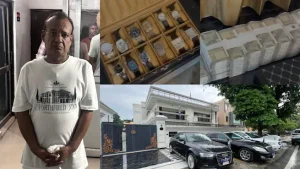Ghaziabad, Uttar Pradesh – In a stunning revelation that has shocked the diplomatic community, the Fake Embassy Ghaziabad operation run by Harshvardhan Jain has been exposed after seven years of sophisticated deception. The elaborate fraud involved an MBA graduate posing as a diplomat for fictitious nations while operating from a lavish bungalow in Kavi Nagar, conducting illegal activities under the guise of diplomatic immunity.
The Mastermind Behind the Diplomatic Deception

Harshvardhan Jain, the architect of the Fake Embassy Ghaziabad operation, presents a complex profile of educational achievement turned criminal enterprise. An MBA graduate from both the London College of Applied Science and Ghaziabad’s ITS college, Jain possessed the credentials and sophistication necessary to execute such an elaborate fraud.
Born into a business family in Ghaziabad, Jain’s early life was marked by privilege, with his family owning marble mines in Rajasthan. However, following his father’s death and subsequent financial troubles, Jain’s trajectory took a dramatic turn that would eventually lead to the Fake Embassy Ghaziabad scheme.
The financial hardships following his father’s demise became a turning point in Jain’s life, setting the stage for his eventual descent into criminal activities. His educational background and family business experience provided him with the knowledge and connections that would later prove instrumental in establishing the Fake Embassy Ghaziabad operation.
Connection with Controversial Figures

Jain’s criminal journey gained momentum through his association with controversial godman Chandraswami, a relationship that would prove pivotal in his later fraudulent activities. With Chandraswami’s assistance, Jain moved to London and established several companies that probe agencies later discovered were used to hide unaccounted money.
The Fake Embassy Ghaziabad mastermind also maintained connections with international arms dealer Adnan Khashoggi, as revealed during initial investigations. These high-profile associations provided Jain with the international credibility and network necessary to sustain his fraudulent diplomatic persona for seven years.
After Chandraswami’s death, Jain returned to Ghaziabad and initiated the Fake Embassy Ghaziabad operation, leveraging his international experience and connections to create an elaborate facade of diplomatic legitimacy. His time in London had provided him with the sophistication and international exposure necessary to convincingly impersonate diplomatic personnel.
Elaborate Facade of Diplomatic Legitimacy

The Fake Embassy Ghaziabad operation was characterized by meticulous attention to detail and luxury that convinced many of its authenticity. Jain operated from a lavish bungalow that served as his fake embassy headquarters, complete with all the trappings expected of a genuine diplomatic mission.
His fleet of luxury vehicles, including an Audi and Mercedes, displayed diplomatic number plates that added credibility to his false diplomatic status. This Fake Embassy Ghaziabad setup was so convincing that it operated in plain sight for seven years without arousing suspicion from authorities or neighbors.
Jain claimed to serve as consul and ambassador for several non-existent countries, including Westarctica, Saborga, Poulvia, and Lodonia. The choice of micronations that are not recognized by any legitimate state was strategic, as it made verification difficult while providing the appearance of legitimate diplomatic representation.
Fraudulent Activities and Criminal Operations


Behind the diplomatic facade, the Fake Embassy Ghaziabad operation served as a front for multiple criminal activities. Jain’s primary illegal enterprises included running job fraud schemes and operating a hawala racket through various shell companies established during his time in London.
The job fraud component of the Fake Embassy Ghaziabad operation involved brokering deals for companies and individuals seeking work abroad. Jain allegedly promised people and companies overseas employment opportunities, only to defraud them of their money while providing no genuine services.
His hawala racket represented a sophisticated money laundering operation that used the Fake Embassy Ghaziabad as a front for illegal financial transactions. The diplomatic cover provided legitimacy to international money transfers that might otherwise have attracted regulatory scrutiny.
Sophisticated Deception Techniques
To enhance his credibility, Jain created morphed photographs showing himself with prominent political figures, including Prime Minister Narendra Modi and former President Dr. APJ Abdul Kalam. These fabricated images were crucial to the Fake Embassy Ghaziabad operation’s success, as they provided apparent evidence of high-level political connections.
The use of forged documentation was extensive, with Jain possessing fake Ministry of External Affairs seals, diplomatic passports, and various official-looking credentials. This comprehensive approach to document forgery made the Fake Embassy Ghaziabad operation appear authentic to potential victims and casual observers.
Previous Criminal History
The Fake Embassy Ghaziabad arrest was not Jain’s first encounter with law enforcement. In 2011, he was found in possession of illegal satellite phones, leading to a case being registered at the Kavi Nagar police station in Ghaziabad. This earlier incident suggests a pattern of illegal activity that culminated in the elaborate diplomatic fraud.
UP Police Additional Director General Amitabh Yash confirmed this criminal history, indicating that authorities had previous knowledge of Jain’s questionable activities. However, the sophistication of the Fake Embassy Ghaziabad operation allowed him to avoid detection for seven years.
Extensive Evidence Seizure


When the Uttar Pradesh Special Task Force finally raided the Fake Embassy Ghaziabad operation, they discovered an extensive cache of evidence documenting the fraud’s scope. The seizure included over ₹44 lakh in cash, foreign currency from multiple countries, and four vehicles equipped with diplomatic number plates.
Additionally, authorities recovered 18 spare diplomatic number plates, 12 diplomatic passports from various micronations, forged documents bearing Ministry of External Affairs seals, two fake PAN cards, 34 seals from different countries and companies, two fraudulent press cards, and numerous company documents.
Impact and Legal Consequences
The exposure of the Fake Embassy Ghaziabad operation has significant implications for diplomatic security and fraud prevention measures. The case highlights vulnerabilities in verification systems and demonstrates how sophisticated criminals can exploit diplomatic protocols for illegal gain.
The comprehensive evidence collected during the raid ensures that legal proceedings will address multiple charges, including fraud, forgery, money laundering, and diplomatic impersonation. This landmark case will likely lead to enhanced security measures for diplomatic verification and increased scrutiny of suspicious diplomatic activities in the future.

